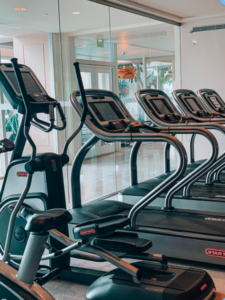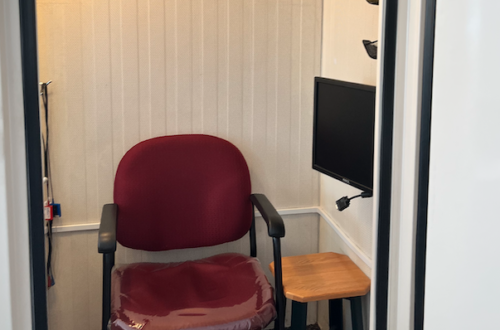
New Year’s Health Resolutions? Don’t set yourself up to fail.
New Year’s resolutions are common. Every year, we read articles about how we can improve our lives and things we should do to accomplish that. And every year, we hear about people who tried but say they failed. Maybe we’re among them.

I don’t do New Year’s resolutions. To pick one date out of 365 of them (or 366 this year) when everyone else is doing the same thing is stressful. Look at the gyms. The first few weeks in January, they’re packed with folks with the best of intentions to “get in shape.” After gaining a few pounds over the holiday, or seeing the holiday pictures with an extra chin or two, many are motivated to “make a new start.” I know my gym sees an uptick in visitors every year as soon as it reopens on January 2. Some of them stay, but it doesn’t take long before I see fewer and fewer of the new folks.
Best of intentions
The new people started with the best of intentions but either life got in the way, or they really didn’t want to do it once they started. Think about it. I live in Montreal. I go to the gym any time between 6 and 7 a.m., depending on the day. When I leave to walk the two blocks to the gym, it’s still dark. It’s cold. It’s slippery and I don’t want to be outside. I really don’t want to be outside.
If you’re new to the gym and going first thing in the morning before work is the only way you can do it – is a dark, cold, slippery walk to the gym a good way to start your experience? After a few days, it’s possible that you’re going to wake up in your warm, comfortable bed and think, “Nuh-uh. I’m not bundling up to go out there to go to the gym. I’ll go tomorrow.” Or you may sleep through your alarm and see that you have only 30 minutes rather than your typical 60 minutes to work out, so you say, “tomorrow.” Then tomorrow and the next day there are other excuses until you realize you’re just not going anymore. And then you might feel like a failure.
You didn’t fail
I don’t think you actually failed even though you may have unintentionally set yourself up to fail. Let me explain.
If you can only exercise in the morning, why not try before winter? Why not start when days are longer and you can walk to the gym in the warmer weather, and it’s not so hard to get out of bed? Then, if you like what you’re doing, and you get into a really good routine, when winter comes around, you’re in  the groove. Yes, it is still not fun to go out in the cold, dark morning, but it’s something that you do now. It’s not something that you need to learn to do. Don’t forget, it typically takes 21 to 30 days to form a new habit (and thus the popularity of the “whole30” movement), so trying to build that routine through 21 subzero days of January is much less likely to be successful than 21 sunny days in mid-July.
the groove. Yes, it is still not fun to go out in the cold, dark morning, but it’s something that you do now. It’s not something that you need to learn to do. Don’t forget, it typically takes 21 to 30 days to form a new habit (and thus the popularity of the “whole30” movement), so trying to build that routine through 21 subzero days of January is much less likely to be successful than 21 sunny days in mid-July.
Of course, going to the gym isn’t the only way to get fit. You can exercise at home. There are lots of online exercise sites that can help you get into a routine. But I get it. Some people just can’t do it. I know I can’t. Aside from being unable to stay on track, my exercise is using the rowing machine. There’s no space in my home for one of those – so the gym is a must.
Sometimes, having an accountability partner helps you develop a new routine. If you promised your friend Sally that you’d meet at 6 am for the early yoga class, you are more apt to attend as you don’t want to let Sally down and you may be looking forward to socializing. By building a community, you can increase your likelihood for success and share that success with your community. Or you can couple a new activity with one you already enjoy. Reward yourself with your favorite podcast as you workout on the elliptical for 45 minutes. Or read your favorite murder mystery as you use the treadmill.
Other resolutions
Other health-related resolutions often include stopping smoking, eating healthier diets, and taking time for self-care. All are admirable, but as with exercising, you need to do it in a way that will help you.
Smoking:
Setting a quit date is a good start – but it doesn’t have to be January 1st. That can put a lot of pressure on you. Why not a random Wednesday, a family member’s birthday, or an anniversary? Pick a date not too far in the future and start planning. Why plan? Because smoking doesn’t occur in a vacuum, and you may need help with smoking cessation tools, like a patch or gum.
 Usually, people have triggers for smoking. Some only smoke when they go out to a bar, others smoke when they have their morning coffee or at break time at work. What will you do instead? Know beforehand what you’ll do. If you enjoy going out for a smoke at work, maybe a walk around the block? Or you can read a good book, saved just for that time?
Usually, people have triggers for smoking. Some only smoke when they go out to a bar, others smoke when they have their morning coffee or at break time at work. What will you do instead? Know beforehand what you’ll do. If you enjoy going out for a smoke at work, maybe a walk around the block? Or you can read a good book, saved just for that time?
Should you share your quit date with others? Most people say yes, you should. This helps keep you accountable, and they can support you. Another technique is to share your desire to be smoke free with others so that if you are “caught,” you have to donate to a charity you hate. The thought of being forced to give your hard-earned cash to a cause you despise can serve as an extra motivator. But if you are a very private person, these options may scare you. So you need to decide what is right for you.
Other things to consider
Are you afraid of gaining weight while quitting? It’s common because people often replace smoking with eating. What might help you stop that? Start an exercise routine? Prepare balanced meals and snacks ahead of time? Check out your favorite restaurant’s menu to decide what to order when you’re there next? What about when you’re bored? What will you do with your hands? Do you want to learn how to do origami and fold up papers to keep your hands busy? What can you replace the smoking motions with? Perhaps some deep breathing exercises like box breathing which can mimic the calming effect of taking a deep breath, but without the inhalation of nicotine and its dangerous byproducts?
This Harvard Health article has several tips on stopping smoking. If quitting is on your mind for this year, give it a try. And if it doesn’t work the first time, nothing is stopping you from trying again later. The important thing is to reflect on your previous attempts and determine what was helpful and what was not helpful in your journey to be nicotine free. Write down your reasons why. Put up a photo of a cancerous lung on your mirror, or a picture of your grandchild you want to see graduate from high school.
Eating a healthier diet
A common resolution, especially after the heavy eating many of us tend to do over the holiday season, is to eat a healthier diet. It can be hard to eat in a healthy way if you live in a food desert or have limited resources. So choosing healthy eating might be more challenging. But sometimes just making some small changes can make a big difference. Don’t automatically add salt to your food, eat smaller portions, and bake or broil instead of frying, perhaps.
Other ideas could be to see if there is a local group that gets together to cook in bulk, with everyone pitching in and taking home some of the results. There are apps like Too Good to Go, which allow you to buy products at the end of a store’s day that would normally go to waste. It can take more effort to eat more healthily and it can be hard to adjust to it if you’re not used to it, but if you think about why you’re making the changes, it may be easier.
Another tip
It is very common to have “decision fatigue” at the end of the day, so planning your menu for the week can be helpful with this. Also, get rid of the temptations. If you don’t have chocolate in the home, you are less likely to consume it.
 If you’re not quite ready to make the change, why not keep a food journal for a few weeks? Write down everything you consume throughout the day (and night!). You might be surprised at what and how much you eat and drink. Commonly, people will forget 30 to 60% of the calories that they consume a day unless they write down their food intake immediately. That half cookie your son didn’t finish at lunch? Your second helping of garlic bread at supper? The extra bit of ice cream you added to your pie? That all adds up over time. There are also apps to help. Just be sure to check that they accurately record your data.
If you’re not quite ready to make the change, why not keep a food journal for a few weeks? Write down everything you consume throughout the day (and night!). You might be surprised at what and how much you eat and drink. Commonly, people will forget 30 to 60% of the calories that they consume a day unless they write down their food intake immediately. That half cookie your son didn’t finish at lunch? Your second helping of garlic bread at supper? The extra bit of ice cream you added to your pie? That all adds up over time. There are also apps to help. Just be sure to check that they accurately record your data.
You might find a pattern. Maybe you only eat unhealthy foods when you’re feeling a certain way. Perhaps you eat a lot on certain days. A journal can help you identify these patterns.
Once you’re ready to start changing your diet, you can do it all at once, or you can start replacing some foods with healthier options. The Department of Agriculture has a My Plate site that helps people learn about healthy eating in a simple way. You can also consult with a dietitian if you need help. Ask your doctor’s office if they have one on staff or if they can recommend someone. Sometimes, it just takes a couple of consultations to get going in the right direction.
Self-care
This may be the most challenging resolution for some people to keep. Many of us were taught that we have to work hard and do something all the time. Taking time for self-care can make us feel anxious, like we’re doing something we’re not supposed to.
 Only you can decide what self-care means to you. It can be taking a bubble bath and reading a couple of evenings a week, going out to karate class, swimming laps at the local pool, going for regular massages, or meeting up with friends regularly. Whatever self-care means to you, it’s essential. In today’s busy society, you may need to make time for it, though, and it might not be easy. Are you a busy single parent? Can you trade-off with another parent? Can you take the kids for a few hours one week, and the other parent do it the next? Do you have tight finances? Self-care doesn’t have to cost anything. It can be going to the library and browsing through magazines, going for regular walks through your neighborhood, or meeting up with a friend.
Only you can decide what self-care means to you. It can be taking a bubble bath and reading a couple of evenings a week, going out to karate class, swimming laps at the local pool, going for regular massages, or meeting up with friends regularly. Whatever self-care means to you, it’s essential. In today’s busy society, you may need to make time for it, though, and it might not be easy. Are you a busy single parent? Can you trade-off with another parent? Can you take the kids for a few hours one week, and the other parent do it the next? Do you have tight finances? Self-care doesn’t have to cost anything. It can be going to the library and browsing through magazines, going for regular walks through your neighborhood, or meeting up with a friend.
Whatever changes you want to make, don’t limit yourself to January 1. Make the changes when you’re ready to do them. You’ll be more likely to succeed.
Still not sure?
Go through your calendar and look for events in the past week, month, or year that were enjoyable and you’d like to repeat. Mark them with a plus. Find events that were challenging that you do NOT wish to repeat. Mark them with a minus. Actively choose to fill your life with more of the +s and less of the -s.
Take time out to actively schedule time with people who bring joy and happiness in your life. Schedule time with friends and family, THEN schedule your work responsibilities if you can. Don’t let your loved ones be an afterthought. By actively scheduling time with those who are important to you, you become less available to those who seem to take energy from you. We know that not everyone can do this for financial reasons, but if you can, planning like this makes it easier for you to turn down requests from work for overtime or extra shifts. You can say you’re unavailable because you already have plans. You deserve to schedule downtime. Go ahead and make it happen!
Still need help?
Still concerned that you “need a nudge”? Join a group with the same goal in mind. Do you want to quit drinking? Consider joining Alcoholics Anonymous or find an online community with similar goals like Instagram and Facebook’s #sobercurious movement. Look for apps that focus on the same goals, like weight loss (Noom) or alcohol cessation (Reframe). There are apps for breaking bad habits and apps for developing new habits. And some that will do both. HeadSpace, Quit It, EveryDay, habitica, productive, strides, Way of life, and Quitzilla are just a few. Make sure that you write down your reasons why you wish to break a bad habit or start a good habit and post this prominently in your work and home space. Consider reading the book (while you are on the treadmill perhaps?) Atomic Habits by James Clear for more ideas.
Disclaimer
The information in this blog is provided as an information and educational resource only. It is not to be used or relied upon for diagnostic or treatment purposes.
The blog does not represent or guarantee that its information is applicable to a specific patient’s care or treatment. The educational content in this blog is not to be interpreted as medical advice from any of the authors or contributors. It is not to be used as a substitute for treatment or advice from a practicing physician or other healthcare professional.




